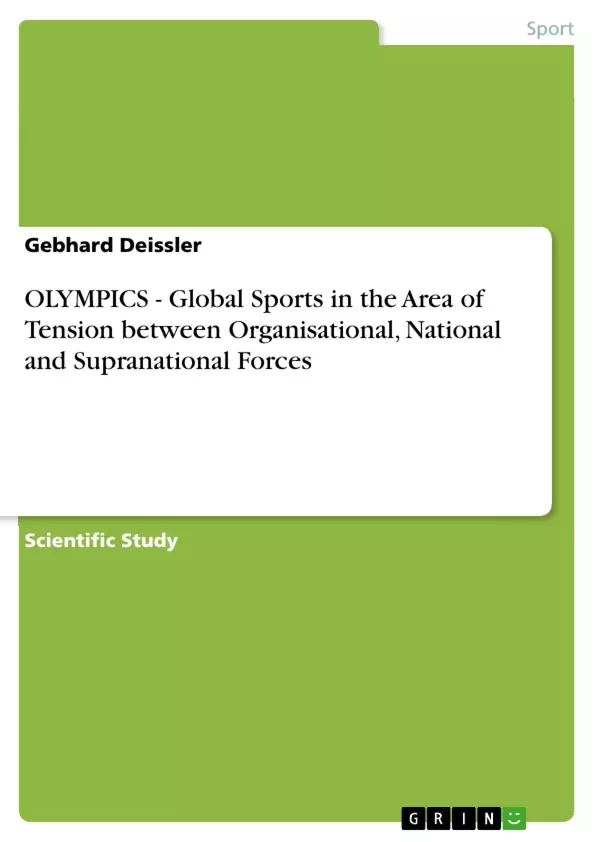This study looks at global sports and more specifically at global soccer from historical, cultural, economic, social, strategic/tactical and civilization perspectives. Sports as a global management phenomenon and practice are contextualized in a global transcultural management framework. Its aim is the optimum use of cultural diversity and to create awareness of divisive dimensions in global sports, while it offers a consistenet approach to the integration of divisive tendencies in the global world of sports. This will in turn sustainably affect other domains of the globalizing world.
Inhaltsverzeichnis (Table of Contents)
- Part 1
- PANEM ET CIRCENSES
- THE GLOBAL SPORTS BUSINESS
- INTERCULTURAL SPORTS AND SOCCER
- MANAGEMENT...6
- TEN DIMENSIONS OF GLOBAL SPORTS MANAGEMENT
- INTERCULTURAL SPORTS AND SOCCER
- 1. THE NATION AS THE DOMINANT FORCE: THE CULTURAL AMBIVALENCE INHERENT IN THE OLYMPIC GAMES AND IN GLOBAL SPORTS...7
- 2. THE SOCIO-HISTORICAL ASPECT...16
- 3. THE CULTURAL IMPERATIVE OF GLOBAL SPORTS...19
- 4. SOCCER FROM AN ECONOMIC AND A POLITICAL STANDPOINT...22
- 5. SOCCER FROM A SOCIOPSYCHOLOGICAL PERSPECTIVE...29
- 6. CULTURAL STRATEGY, TACTICS AND STYLES OF SOCCER...32
- 7. THE WESTERN CULTURAL BIAS WITH REGARD TO THE CULITVATION OF HUMAN BODY, MIND AND SPIRIT AND COMPLEMENTARY APPROACHES TO HUMAN INTEGRITY AND WHOLENESS...44
- 8. ORIENT AND OCCIDENT: EAST-WEST SYNERGY...53
- 9. A UNIVERSAL CULTURE OF COMMUNICATION FOR THE GLOBAL ERA...61
- 10 A UNIVERSAL TOOL FOR INTERNATIONAL DIVERSITY MANAGEMENT: THE TRANSCULTURAL PROFILER...70
- THE GLOBAL SPORTS BUSINESS
- PANEM ET CIRCENSES
- Part 2
- CULTURALLY INTEGRATIVE GLOBAL SPORTS MANAGEMENT...75
- VISHUA CHAYTANA: THE FORMULATION OF A GLOBAL CONSCIOUSNESS-BASED INTER/TRANSCULTURAL MANAGEMENT SCIENCE
- 1. The Completion Of The Intercultural Edifice...76
- 2. Design Of A Scientifically-Based Diversity-Integrative Transcultural Profiler...84
- 2.1 The State Of The Intercultural Art And Science: On Human Relativity In Intercultural Research
- 2.2 Enhancing The Intercultural Art And Science: Sources, Models And The Achievement Of Supreme Cultural Intelligence...92
- 3. Three Dozen Inter-/Transcultural Management Instruments...143
- Part 3
- English Transcultural Management Dictionary...160
Zielsetzung und Themenschwerpunkte (Objectives and Key Themes)
This work aims to explore the complexities of global sports management within the context of intercultural and transcultural forces. It examines the tension between organizational, national, and supranational forces in shaping the global sports landscape.
- The role of the nation as the dominant force in global sports
- The socio-historical aspect of global sports
- The cultural imperative of global sports
- The economic and political dimensions of soccer
- The development of a culturally integrative global sports management framework
Zusammenfassung der Kapitel (Chapter Summaries)
Part 1, "PANEM ET CIRCENSES," delves into the global sports business and its intercultural complexities. The chapters explore the cultural ambivalence inherent in the Olympic Games and global sports, the socio-historical context of global sports, the cultural imperative of global sports, and the economic and political dimensions of soccer. It also examines soccer from a sociopsychological perspective and analyzes cultural strategy, tactics, and styles of soccer. This part concludes with a discussion of the Western cultural bias in relation to the cultivation of human body, mind, and spirit, as well as the potential for East-West synergy in global sports. It introduces a universal culture of communication for the global era and a transcultural profiler as a tool for international diversity management.
Part 2, "CULTURALLY INTEGRATIVE GLOBAL SPORTS MANAGEMENT," focuses on the development of a global consciousness-based inter/transcultural management science. The chapters discuss the completion of the intercultural edifice, the design of a scientifically-based diversity-integrative transcultural profiler, and the state of the intercultural art and science, including human relativity in intercultural research. It explores sources, models, and the achievement of supreme cultural intelligence in the context of enhancing the intercultural art and science. Finally, this part introduces over three dozen inter/transcultural management instruments.
Schlüsselwörter (Keywords)
The text focuses on the key concepts of global sports, intercultural management, transcultural management, diversity, cultural intelligence, and the Olympic Games. It examines the intersection of national, organizational, and supranational forces within a global context, exploring the role of cultural strategy, tactics, and styles of soccer in shaping the global sports landscape. The text also delves into the development of a universal culture of communication and a transcultural profiler for international diversity management.
- Arbeit zitieren
- D.E.A./UNIV. PARIS I Gebhard Deissler (Autor:in), 2012, OLYMPICS - Global Sports in the Area of Tension between Organisational, National and Supranational Forces, München, GRIN Verlag, https://www.grin.com/document/197283



